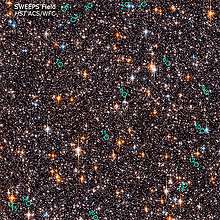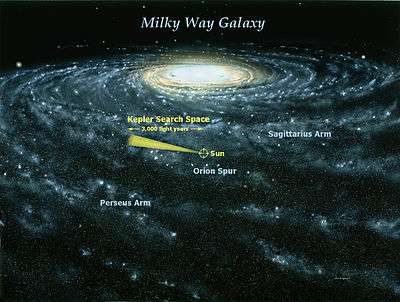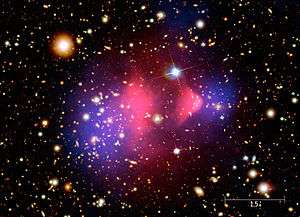Optical Gravitational Lensing Experiment
The Optical Gravitational Lensing Experiment (OGLE) is a Polish astronomical project based at the University of Warsaw that runs a long-term variability sky survey (1992-present). Main goals are the detection and classification of variable stars (pulsating and eclipsing), discoveries of the microlensing events, dwarf novae, studies of the Galaxy structure and the Magellanic Clouds. Since the project began in 1992, it has discovered multitude of extrasolar planets, together with a first planet discovered using transit method (OGLE-TR-56b) and gravitational microlensing method. The project from its inception is led by Prof. Andrzej Udalski.
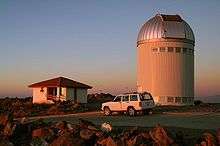 OGLE telescope at the Las Campanas Observatory | |
| Alternative names | OGLE |
|---|---|
| Survey type | astronomical survey, optical telescope |
| Target | gravitational microlensing, exoplanet |
| Organization | University of Warsaw |
| Coordinates | 29°00′36″S 70°41′56″W |
| Observations | Warsaw Telescope |
| Website | ogle |
Description
The main targets of the experiment are the Magellanic Clouds and the Galactic Bulge, because of the large number of intervening stars that can be used for microlensing during a stellar transit. Most of the observations have been made at the Las Campanas Observatory in Chile. Cooperating institutions include Princeton University and the Carnegie Institution.
The project is now in its fourth phase. The first phase, OGLE-I (1992–1995) used the 1.0 m Swope telescope and a single-chip CCD sensor. For OGLE-II (1996–2000), a 1.3 m telescope dedicated to the project (the Warsaw telescope) was constructed at Las Campanas Observatory. It was equipped with a single 2048×2048 pixel sensor with a field of view 0.237 degrees wide.[1] OGLE-III (2001–2009) expanded the camera to a mosaic of eight 2048×4096 pixel CCDs, and was able to search for gravitational microlensing events and transiting planets in four fields: the Galactic Bulge, the constellation Carina,[2] and toward both Magellanic Clouds. As a byproduct of the constant monitoring of hundreds of millions of stars, the largest catalogs of variable stars were constructed, and the first exoplanets discovered using the microlensing technique were detected. In 2010, following engineering work in 2009, the fourth and current phase, OGLE-IV, was started using a 32-chip mosaic CCD camera which fills the Warsaw telescope's 1.5° field of view.[3] The main goal for this phase is to increase the number of planetary detections using microlensing, enabled by the new camera.
Recently the OGLE team, in cooperation with scientists mostly from USA, New Zealand and Japan, proved that small, Earth-like planets can exist at a significant distance from stars around which they revolve despite there being other stars near them.[4][5]
Planets discovered
At least seventeen planets have so far been discovered by the OGLE project. Eight of the planets were discovered by the transit method and six by the gravitational microlensing method.
Planets are shown in the order of discovery. Planets in multiple-planet systems are highlighted in yellow. Please note that list below may not be complete.
| Star | Constellation | Right ascension |
Declination | App. mag. |
Distance (ly) | Spectral type |
Planet | Mass (MJ) |
Radius (RJ) |
Orbital period (d) |
a (AU) |
ecc. | incl. (°) |
Discovery year |
|---|---|---|---|---|---|---|---|---|---|---|---|---|---|---|
| OGLE-TR-10[6][7] | Sagittarius | 17h 51m 28s | −29° 52′ 34″ | 15.78 | 5000 | G2V | OGLE-TR-10 b | 0.63 | 1.26 | 3.10129 | 0.04162 | 0 | 84.5 | 2002 |
| OGLE-TR-111 | Carina | 10h 53m 01s | −61° 24′ 20″ | 16.96 | 5000 | G | OGLE-TR-111 b | 0.53 | 1.0 | 4.01610 | 0.047 | 0 | 88.1 | 2002 |
| OGLE-TR-132 | Carina | 10h 50m 34s | −61° 57′ 25″ | 15.72 | 7110 | F | OGLE-TR-132 b | 1.14 | 1.18 | 1.689868 | 0.0306 | 0 | 85 | 2003 |
| OGLE-TR-56 | Sagittarius | 17h 56m 35s | −29° 32′ 21″ | 16.56 | 4892 | G | OGLE-TR-56 b | 1.29 | 1.30 | 1.211909 | 0.0225 | 0 | 78.8 | 2003 |
| OGLE-TR-113 | Carina | 10h 52m 24s | −61° 26′ 48″ | 16.08 | 1800 | K | OGLE-TR-113 b | 1.32 | 1.09 | 1.4324757 | 0.0229 | 0 | 89.4 | 2004 |
| OGLE-2003-BLG-235L /MOA-2003-BLG-53L | Sagittarius | 18h 05m 16s | −28° 53′ 42″ | 19000 | K | OGLE-2003-BLG-235Lb | 2.6 | 4.3 | 2004 | |||||
| OGLE-2005-BLG-071L | Scorpius | 17h 50m 09s | −34° 40′ 23″ | 19.5 | 9500 | M | OGLE-2005-BLG-071Lb | 3.5 | 3600 | 3.6 | 2005 | |||
| OGLE-2005-BLG-169L | Sagittarius | 18h 06m 05s | –30° 43′ 57″ | 19.4 | 8800 | M? | OGLE-2005-BLG-169Lb | 0.041 | 0.345 | 2006 | ||||
| OGLE-2005-BLG-390L | Sagittarius | 17h 54m 19s | −30° 22′ 38″ | 21500 | M? | OGLE-2005-BLG-390Lb | 0.018 | 2006 | ||||||
| OGLE-TR-211 | Carina | 10h 40m 15s | −62° 27′ 20″ | 5300 | F | OGLE-TR-211 b | 1.03 | 1.36 | 3.67724 | 0.051 | 0 | ≥87.2 | 2007 | |
| OGLE-TR-182 | Carina | 11h 09m 19s | −61° 05′ 43″ | 16.84 | 12700 | G | OGLE-TR-182 b | 1.01 | 1.13 | 3.9791 | 0.051 | 0 | 85.7 | 2007 |
| OGLE2-TR-L9 | Carina | 11h 07m 55s | −61° 08′ 46″ | 2935 | F3 | OGLE2-TR-L9 b | 4.5 | 1.61 | 2.4855335 | 0.0308 | 2008 | |||
| OGLE-2006-BLG-109L | Sagittarius | 17h 52m 35s | −30° 05′ 16″ | 4900 | OGLE-2006-BLG-109Lb | 0.71 | 1825 | 2.3 | 2008 | |||||
| OGLE-2006-BLG-109L | Sagittarius | 17h 52m 35s | −30° 05′ 16″ | 4900 | OGLE-2006-BLG-109Lc | 0.27 | 5100 | 4.8 | 0.11 | 59 | 2008 | |||
| OGLE-2012-BLG-0026L | 17h 34m 19s 17:34:19.0 | −27° 08′ 34″ | 4080 | OGLE-2012-BLG-0026Lb | 0.11 | 3.82 | 2012 | |||||||
| OGLE-2012-BLG-0026L | 17h 34m 19s | −27° 08′ 34″ | 4080 | OGLE-2012-BLG-0026Lc | 0.68 | 4.63 | 2012 | |||||||
| OGLE-2011-BLG-0251 | 17h 38m 14s | −27° 08′ 10″ | 8232 | M | OGLE-2011-BLG-0251 b | 0.53±0.21 | 2.72±0.75 or 1.5±0.5 | 2013 | ||||||
| OGLE-2007-BLG-349(AB) | OGLE-2007-BLG-349(AB)b | 2016 | ||||||||||||
| OGLE-2016-BLG-1195L | OGLE-2016-BLG-1195Lb | 2017 |

Notes: For events detected by the gravitational microlensing method, year stands for OGLE season, BLG means that an event detected is in the Galactic BuLGe, and the following 3-digit number is an ordinal number of microlensing event in that season. For events detected by the transit method TR stands for TRansit and the following 3-digit number is an ordinal number of transit event.
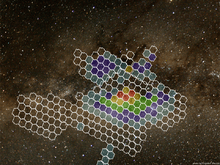
See also
- Variable stars
- Cepheids
- All Sky Automated Survey
- Bohdan Paczyński
- Grzegorz Pojmański
- List of planetary systems
- Microlensing Observations in Astrophysics (MOA)
References
- Udalski, A.; Kubiak, M.; Szymański, M. (1997). "Optical Gravitational Lensing Experiment. OGLE-2 – the Second Phase of the OGLE Project" (PDF). Acta Astronomica. 47 (3): 319–344. arXiv:astro-ph/9710091. Bibcode:1997AcA....47..319U. CiteSeerX 10.1.1.315.9784.
- Udalski, Andrzej (2003). "The Optical Gravitational Lensing Experiment. Real Time Data Analysis Systems in the OGLE-III Survey" (PDF). Acta Astronomica. 53 (4): 291–306. arXiv:astro-ph/0401123. Bibcode:2003AcA....53..291U. CiteSeerX 10.1.1.316.4693.
- Udalski, A.; Szymański, M.K.; Szymański, G. (2015). "OGLE-IV: Fourth Phase of the Optical Gravitational Lensing Experiment" (PDF). Acta Astronomica. 65 (1): 1–38. arXiv:1504.05966. Bibcode:2015AcA....65....1U.
- "Laureaci FNP odkryli zimną Ziemię". 2014-07-07.
- Gould, A.; et al. (4 July 2014). "A terrestrial planet in a ~1-AU orbit around one member of a ~15-AU binary". Science. 345 (6192): 46–49. arXiv:1407.1115. Bibcode:2014Sci...345...46G. doi:10.1126/science.1251527. PMID 24994642.
- Udalski, A.; et al. (2002). "The Optical Gravitational Lensing Experiment. Search for Planetary and Low-Luminosity Object Transits in the Galactic Disk. Results of 2001 Campaign". Acta Astronomica. 52 (1): 1–37. arXiv:astro-ph/0202320. Bibcode:2002AcA....52....1U.
- Konacki, Maciej; et al. (2005). "A Transiting Extrasolar Giant Planet around the Star OGLE-TR-10". The Astrophysical Journal. 624 (1): 372–377. arXiv:astro-ph/0412400. Bibcode:2005ApJ...624..372K. doi:10.1086/429127.
External links
- OGLE Homepage in Warsaw, Poland
- OGLE-IV sky coverage maps
- Detailed OGLE-IV fields diagrams
